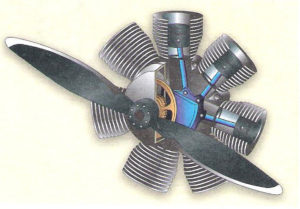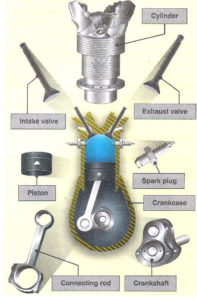How Does a Radial Engine Work?
We have discussed how Tommy flies. How his wing ‘Lifts’ and his propeller provides ‘Thrust’ to ‘Propel’ him forward. But, without his Radial Engine to spin the propeller to pull him through the air so that his wing can lift him into the air, Tommy would just be a ground bound display aircraft.
How about a little background first? The engine that powers Tommy is the same basic engine in all T-6s and SNJs. The Navy designation for the T-6, and the Canadian ‘Harvards’. It has 9 pistons in a circle connected to one main shaft or rod. Those 9 pistons all have what is called a spark plug. That spark plug uses electricity to spark a mixture of gasoline, one at a time, pushing the rod in a circle to make the propeller spin and pull Tommy through the air.

Now, let’s get more technical for those of you interested.
It is an R-1340, 9-cylinder radial, where the R-1340 indicates ‘Radial, 1340 cu.in.’ Made by the Pratt & Whitney Company of Hartford Connecticut, they called it “The WASP.” Depending on the model it has produced from 450 up to 650 Horsepower. It was initially completed on Christmas Eve, 1925. And weighs about 650 pounds.
So, let’s talk about the powerplant. It is a reciprocating, meaning back and forth, piston engine consisting of nine cylinders arranged in a circle. It converts back and forth, or up and down, motion of the piston into a rotating action by connecting the pistons to the connecting rods, or arms, to the Master Rod mounted on the crankshaft. On the other end of the crankshaft is the Hub to which the Propeller is mounted.
The great majority of reciprocating engines, sometimes referred to as “Recips”, are what is known as four cycle engines. Meaning that the piston in the cylinder goes through four cycles with two rotations of the crankshaft. They are the Intake, Compression, Power and Exhaust cycles.
When the starter is engaged, the crankshaft is rotated and begins moving the pistons. On the down stroke of a piston, the intake valve will open through the action of the cam. This allows a fuel and air mixture to enter the cylinder through the Carburetor. As the piston reaches the bottom, the intake valve will close. This is the First Stroke, or Intake Stroke.
Now, through the first rotation of the crankshaft, the piston moves up to the top of the cylinder as it compresses the fuel air mixture. This is the Second Stroke, or the Compression Stroke.
Once at or near the top of the cylinder, the two spark plugs fire. An airplane has two per cylinder, unlike your car which has only one per cylinder, for redundancy and reliability. There are also two independent ignition systems, known as Magnetos. The exploding mixture of fuel and air then pushes the piston down forcing the crankshaft to turn. At this point the engine is self-powered and the starter is disengaged. This is the Third Stroke or the Power Stroke.
We now must remove the gasses that are left in the cylinder. So through the second rotation of the crankshaft the piston moves upward, the exhaust valve then opens, again through the action again of the cam, and the gasses are exhausted through the valve and out the exhaust manifold. This is the Forth Stroke or the Exhaust Stroke.
Such is the sequence of ANY 4-Stroke internal combustion engine. Depending upon the number of cylinders and construction of a specific power-plant, ALL cylinders go through this in varying firing order of the cylinders installed.
A radial is indeed a complicated piece of machinery. The Radial comes in many sizes of Cubic Inches and Horsepower ratings. With the ‘R’ standing for Radial and the number for the Cubic inch displacement. (Example, the R-1830 for the DC-3 / C-47.) We have discussed the 4 cycles and we will attempt in future posts to explain how the fuel is delivered by the Carburetor. How the valve train works through the action of the cam and the how the Spark Plugs fire with the Magnetos.
The Radial doubles in complexity when you add another row, or ‘Bank’ of cylinders. Such as those on the Douglas DC-3/C-47, R-1830, the Vought F4U Corsair or the Republic P-47 Thunderbolt, R-2800.
Questions? E Mail me.
Blue Skys and Tailwinds
Tommy Merchandise
Buy Tommy Merchandise such as keychains, backpacks, water bottles and stickers in our Café Press store.
Join Tommy’s Hangar
to receive special updates, exclusive illustrations, and other fun things exclusive to members!

